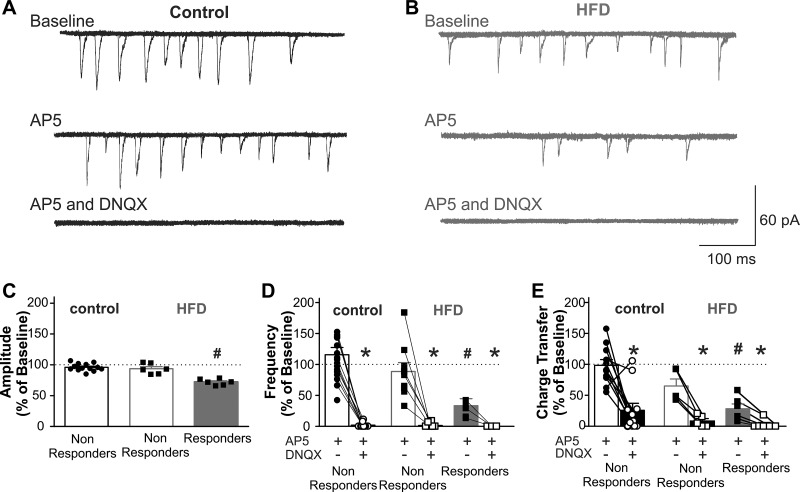Fig. 3.
The N-methyl-d-aspartate receptor (NMDA-R)-selective antagonist, amino-5-phosphonopentanoate (AP5), decreases excitatory synaptic transmission to acute high-fat diet (HFD), but not control, dorsal motor nucleus of the vagus (DMV) neurons. A: 6 overlapping consecutive traces from a control gastric-projecting DMV neuron voltage clamped at −50 mV illustrating miniature excitatory postsynaptic currents (mEPSCs). Perfusion with AP5 (25 μM), had no effect on mEPSC frequency or amplitude in 17/18 neurons. Subsequent application of 6,7-dinitroquinoxaline-2,3-dione (DNQX) (30 μM) abolished all mEPSCs, confirming their glutamatergic nature. B: sample trace of mEPSCs in an acute HFD gastric-projecting DMV neuron, voltage clamped at −50 mV (6 overlapping consecutive traces). Perfusion with AP5 decreased mEPSC amplitude and frequency in 6/15 neurons; subsequent application of DNQX abolished all mEPSCs, confirming the role of both NMDA-R and non-NMDA-R (presumably α-amino-3-hydroxy-5-methyl-4-isoxazolepropionic acid receptor, AMPA-R) in synaptic glutamatergic currents. C: graphical summary of the effects of AP5 on mEPSC amplitude in control (left; n = 17, 8 rats) and acute HFD (right; n = 6 responding neurons and 9 nonresponding neurons, 8 rats) gastric-projecting DMV neurons. Neurons were classified as responsive based on whether there was a significant change in amplitude >25% from baseline. D: graphical summary of the effects of AP5 and DNQX on mEPSC frequency in control (left; n = 17 neurons, 8 rats) and acute HFD (right; n = 6 responding neurons and 9 nonresponding neurons, 8 rats) gastric-projecting DMV neurons. Neurons were classified as responsive based upon the ability of AP5 to decrease mEPSC amplitude. ● and ■ indicated response to AP5; ○ and □ indicate response to AP5 and DNQX. All mEPSCs were abolished by DNQX (control) or a combination of AP5 and DNQX (acute HFD). E: graphical summary of the effects of AP5 and DNQX on mEPSC charge transfer in control (left; n = 17 neurons, 8 rats) and acute HFD (right; n = 6 responding neurons and 9 nonresponding neurons, 8 rats) gastric-projecting DMV neurons. Neurons were classified as responsive based on the ability of AP5 to decrease mEPSC amplitude. ● and ■ indicate response to AP5; ○ and □ indicate response to AP5 and DNQX. *P < 0.05 vs. baseline (Student's paired t-test). #P < 0.05 vs. control (Student's paired t-test).

